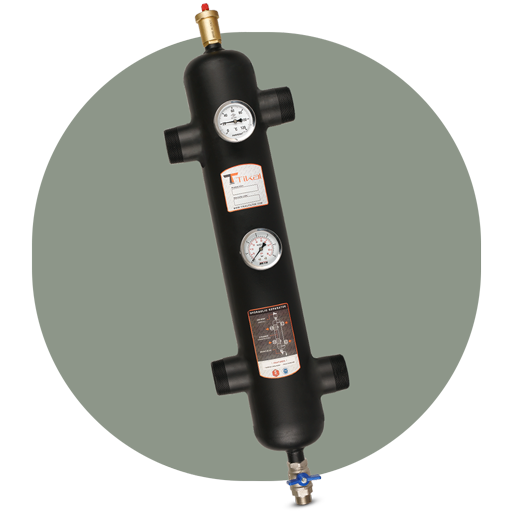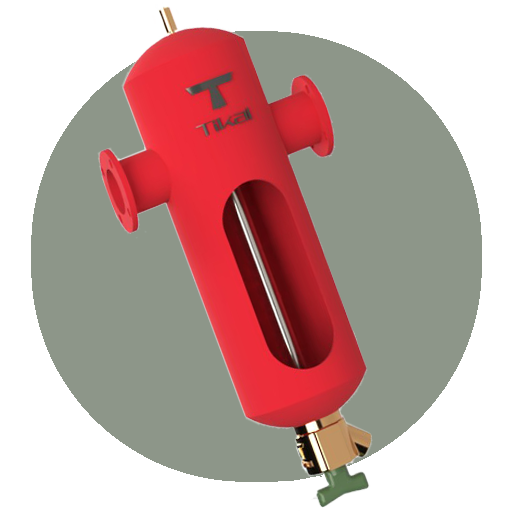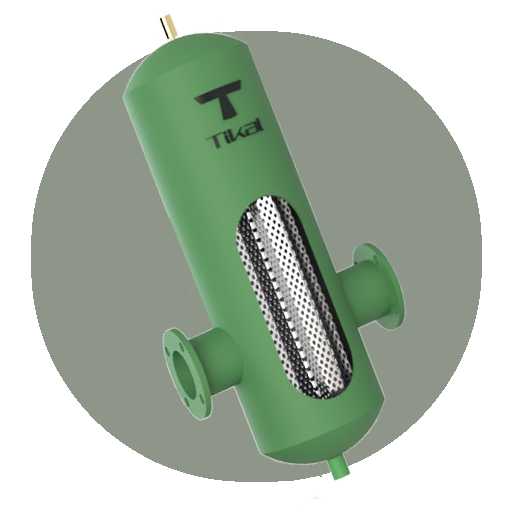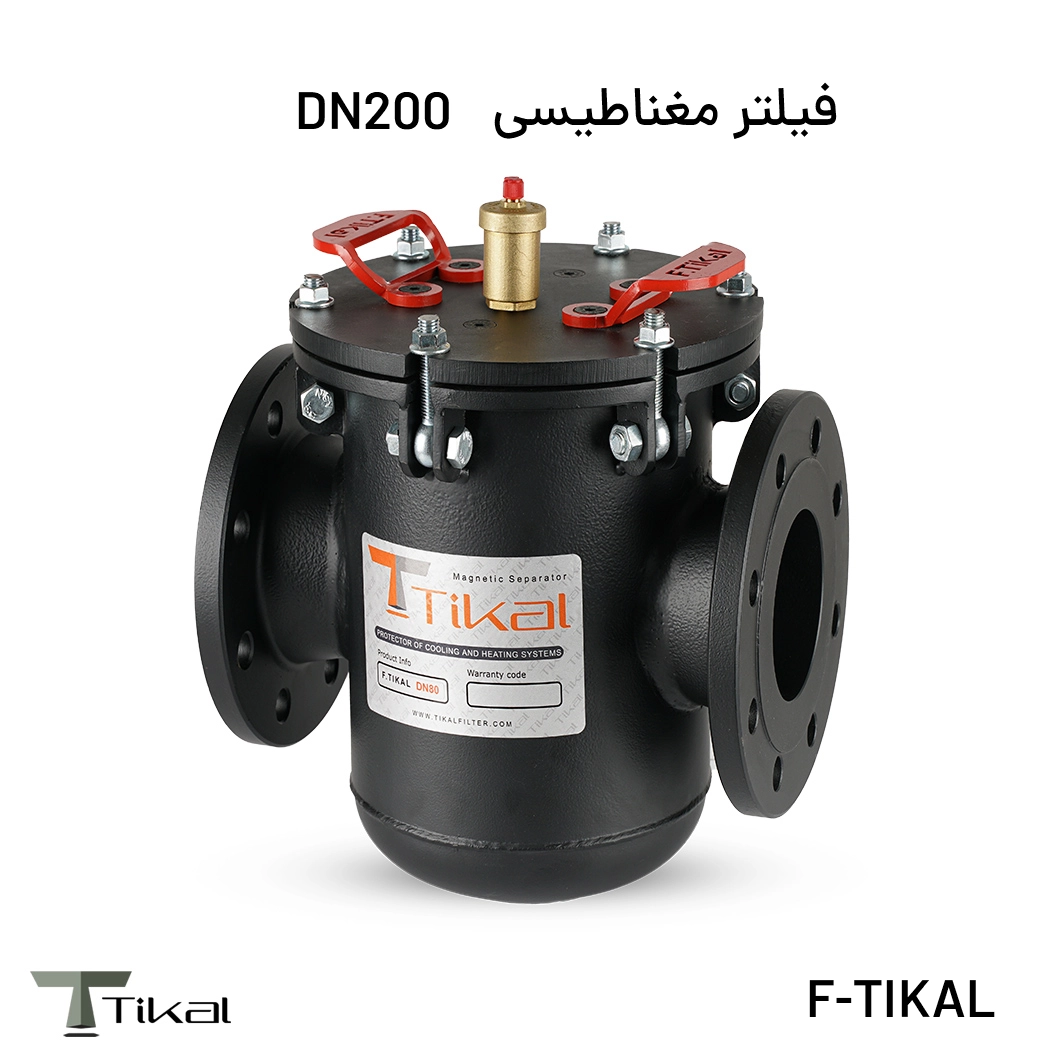Showing all 23 results
FC.Tikal DN100
FC.Tikal DN125
FC.Tikal DN150
FC.Tikal DN200
FC.Tikal Dn32
FC.Tikal DN40
FC.Tikal DN50
FC.Tikal DN65
FC.Tikal DN80
Magnetic Strainer F-TIKAL DN200 pro (کپی)
magnetic strainer
The magnetic strainer is one of the essential tools in heating and cooling systems that, by using strong magnet technology, separates suspended metal particles from the fluid flow. These filters, by attracting and removing metal particles, prevent pipe blockages, reduce damage caused by corrosion, and extend the lifespan of equipment. This article examines magnetic strainers, their functionality, and the benefits of using them in heating and cooling systems.
These filters are produced in three series: f-tikal, s-tikal, and fg-tikal, each with its own unique features, and are recommended based on the existing equipment in the cycle and your specific needs.
? What is a magnetic strainer
A magnetic strainer is a device specifically designed to remove suspended metal particles from fluid flows. These filters utilize strong magnets to separate metal particles from the fluid. Heating and cooling systems are gradually exposed to suspended metal particles, which may cause blockages or reduce system efficiency. Magnetic filters provide an effective solution to prevent these issues.
Features of magnetic strainers
- Rapid Metal Particle Capture: Strong magnets quickly attract metal particles.
- Extended Equipment Lifespan: Preventing blockages and corrosion damage increases the system’s service life.
- Reduced Maintenance Costs: By eliminating suspended particles, the need for frequent repairs is minimized.
How magnetic strainer Work
magnetic strainers operate by placing strong magnets in the path of the fluid flow, attracting and capturing suspended metal particles to prevent them from passing through. When fluid containing metal particles flows through the filter, these particles adhere to the magnets and are separated from the fluid stream. This process helps reduce issues caused by corrosion and blockages, leading to improved system efficiency.
Types of magnetic strainer
Magnetic filters are produced in various models and series, each offering unique features tailored to specific system needs and conditions. Below are the three main series of magnetic filters:
| Filter Type | Features | Size |
|---|---|---|
| F-Tikal | Designed for industrial projects according to PN16 standards with flanged connections. | DN50, DN65, DN80, DN100, DN125, DN150, DN200, DN250, DN300 |
| S-Tikal | Suitable for residential and semi-industrial projects requiring threaded connections. | 1″, 1.2″, 1.4″, and 2″ |
| FG-Tikal | Designed for industrial and semi-industrial projects requiring threaded connections. | 1″, 1.2″, 1.4″, and 2″ |
Benefits of Using magnetic strainer
Prevention of Damage Caused by Galvanic Corrosion
Galvanic corrosion occurs when different metals come into contact within a fluid circuit, gradually leading to corrosion over time. magnetic strainers effectively address this issue by removing suspended metal particles from the fluid flow. Preventing damage caused by galvanic corrosion translates to longer equipment lifespan and lower maintenance costs.
In all thermal and cooling cycles, or wherever water is used as the intermediary fluid and two or more metals come into direct contact or establish electrical conduction, a phenomenon called galvanic or bi-metallic corrosion occurs. In this process, the stronger metal (cathode) corrodes the weaker metal (anode), releasing tiny particles of the weaker metal, ranging from 1 to 8 microns in size. These particles remain suspended in the water due to the closed-loop flow of the system and easily pass through standard mesh filters due to their minute size.
These particles can be observed during fan coil cleaning or when opening the drain valves of collectors or boilers, appearing as water or black sludge. These steel particles, commonly referred to as magnetite or black sludge, are the primary cause of significant damage to heating and cooling systems.
System Efficiency Improvement
Reducing Maintenance Costs
One of the most significant advantages of magnetic strainers is reducing maintenance costs. By removing harmful particles and preventing damage caused by corrosion and blockages, the need for frequent repairs and replacement of sensitive components is greatly diminished. This translates to lower operational costs and increased system efficiency.
Preventing Damage to Sensitive Components
In heating and cooling systems, there are sensitive components highly vulnerable to the presence of suspended metal particles. These particles can cause blockages, scratches, or even complete failure of these components. magnetic strainers remove these particles from the fluid circuit, preventing damage to sensitive parts and extending their lifespan.
Preventing Pipe Blockages
One of the common issues in heating and cooling systems is pipe blockages caused by the accumulation of suspended particles. Over time, these particles can build up in the pipes, reducing fluid flow. Using magnetic filters helps prevent this problem, ensuring optimal fluid flow within the system.
Extending Equipment Lifespan
Another key advantage of using a magnetic strainer is extending equipment lifespan. By removing suspended metal particles and reducing damage caused by corrosion and blockages, heating and cooling system components become more durable and require less frequent replacement. This increased equipment lifespan translates to reduced long-term costs.
Reducing Maintenance Costs
Improving the Efficiency of Heating and Cooling Circuits
One of the direct outcomes of using a magnetic filter is the improvement in the efficiency of heating and cooling circuits. Removing suspended particles and preventing potential failures allows the system to operate with higher efficiency, increasing overall performance. This also contributes to reduced energy consumption and lower operational costs.
Technical Advantages
- Suspended Metal Particle Removal: Improves fluid flow quality.
- Prevention of Blockages: Reduces issues related to pipe and flow path obstructions.
- Increased Equipment Lifespan: Minimizes damage caused by corrosion and component failure.
- Efficiency Improvement: Enhances the performance of heating and cooling systems.
Economic Benefits
- Reduced Maintenance Costs: Lowers the operational expenses of the system.
- Lower Energy Costs: Enhances system efficiency and optimizes energy consumption.
- Decreased Replacement Costs: Extends the lifespan of sensitive components and reduces failures.
Table of Benefits of Using magnetic strainer
| Benefit | Description |
| Prevention of Galvanic Corrosion | Removal of suspended metal particles and prevention of contact between different metals, which causes equipment corrosion. |
| Reduced Maintenance Costs | Prevention of issues caused by corrosion and blockages, leading to lower repair and maintenance costs. |
| Prevention of Sensitive Component Damage | Removal of suspended metal particles that cause damage to sensitive components in fluid circuits. |
| Prevention of Pipe Blockages | Prevention of pipe blockages and maintenance of optimal fluid flow in the system. |
| Extended Equipment Lifespan | Prevention of damage caused by corrosion and blockages, resulting in longer equipment life. |
| Lower Maintenance Costs | Reduction in the need for repairs and component replacements, leading to lower system maintenance expenses. |
| Improved Heating and Cooling Circuit Efficiency | Removal of suspended particles and optimization of system performance, improving the efficiency of heating and cooling circuits, and ultimately reducing energy consumption. |
Applications of magnetic strainer
Galvanic Corrosion
The first area affected by galvanic corrosion is the wet pumps or water-cooled pumps. As you know, water-cooled pumps do not have air-driven impellers; they are cooled via circulating fluid. When the water channel at the center of the pump’s rotor is blocked by deposits, water cannot reach the end bush, causing it to run dry. This leads to wear, which prevents the rotor from staying centered. Over time, the rotor pushes against the shell separating the winding and rotor, causing shell abrasion.
The shell, being thin, can develop holes, allowing water to pass from the rotor section to the stator. Eventually, water reaches the winding and exits through the electrical terminals.
One of the most important applications of magnetic strainers is in water-cooled pumps. These pumps rely on cooled fluid for operation due to the absence of air-driven impellers. However, the main problem occurs when suspended metal particles and deposits block the water channel, leading to damage to the pump’s internal components.
Issues Caused by Galvanic Corrosion in Water-Cooled Pumps
- Water channel blockage, preventing water from reaching the bush.
- Dry running of the bush, leading to component wear.
- Rotor wear and pressure on the shell, ultimately damaging the winding and other parts.
Magnetic filters prevent these issues by capturing suspended metal particles, thus protecting against galvanic corrosion. This significantly increases the pump’s service life and reduces the need for frequent repairs.
Galvanic Corrosion in Chillers with Shell-and-Plate Evaporators
Chillers with plate evaporators have advantages over those with shell evaporators, such as lighter structures and excellent heat exchange performance. However, they also have disadvantages, the most significant being the sensitivity of plate evaporators to contamination and the presence of impurities.
The gap between the plates is 2/3 mm, and even the smallest impurity in the water paths can block them. In other words, magnetite particles resulting from corrosion can easily clog the gaps between the plates. This leads to a temperature difference between the inlet and outlet, causing the plates to fail. In other words, certain sections of the evaporator become blocked, and the cooling produced by the compressor is excessively concentrated in specific areas.
Problems Caused by Galvanic Corrosion in Chillers with Shell-and-Plate Evaporators
- Clogging of Plate Gaps by metal particles.
- Significant temperature difference between the inlet and outlet.
- Evaporator damage in some sections, leading to reduced overall system efficiency.
magnetic strainers collect metal particles and prevent them from entering the evaporator, avoiding water path blockages and improving the efficiency of the chiller.
Galvanic Corrosion and Fan Coils
In fan coil systems, due to the low fluid velocity, heavy steel particles have the opportunity to settle in the coils, creating an insulating layer that prevents full heat exchange. This significantly increases energy consumption.
Tikal magnetic strainers are specifically recommended for collecting deposits and particles caused by galvanic corrosion in HVAC and industrial heating and cooling systems.
In general, in any cycle where water is used as an intermediate fluid (preferably closed cycles), Tikal magnetic filters should be used to prevent equipment damage and reduce maintenance costs. Installing these magnetic filters easily and at minimal cost enables up to 80% capture of black sludge.
Galvanic Corrosion in Fan Coils:
- Sedimentation of heavy metal particles and formation of insulating layers.
- Reduced heat exchange and increased energy consumption.
- Higher maintenance and repair costs.
Installing a magnetic filter in the fluid flow path can prevent the accumulation of these particles and improve the efficiency of fan coils.
Installation of magnetic strainer
Installation Location of Tikal Magnetic strainer
One of the most important aspects of installing Tikal Magnetic strainers is selecting the appropriate location. These filters, due to their specific design, are installed in place of Y strainers and do not require additional equipment. Typically, the filters are installed in the return flow path of the fluid towards heating or cooling devices such as boilers or chillers.
Key Points in Selecting the Installation Location
Key Points in Selecting the Installation Location:
- Heating Circuit Return Line: Install in the return path towards the boiler.
- Fan Coil Return Line: Install in the return path towards the chillers.
- Bypass Usage: If possible, install the filter in the bypass line for enhanced particle capture.
Tikal magnetic strainer Installation Guide
Tikal Magnetic Filter Installation Guide
Installing Tikal magnetic filters is very straightforward, and their design allows for both vertical and horizontal installation. However, experts recommend vertical installation for optimal performance.
Installation Steps:
- Vertical Installation: Ensure the filter’s inlet and outlet are horizontal, with the filter body installed vertically.
- Air Vent Installation: In vertical installations, attach an air vent at the port on the filter’s lid to prevent air traps from forming.
- Return Path Installation: Place the filters in the return line of the circuit, directing fluid back to the heating or cooling devices.
- Pipe Size Matching: Install a filter that matches the pipe size. For instance, use a 2-inch filter for 2-inch pipes. Avoid using a smaller-sized filter.
Note 1: Tikal experts recommend vertical installation, with the inlet and outlet horizontal and the filter body vertical.
Note 2: In vertical installations, always attach an air vent to the 1/2-inch port on the filter lid to prevent air traps from forming at the top of the filter body.
Guide for Selecting the Size of magnetic strainer
Choosing the correct size magnetic strainer is one of the most critical steps in installation. The filter size must match the pipe size at the installation location to ensure optimal performance.
| Pipe Size | Magnetic Filter Size |
|---|---|
| 1 inch | 1-inch magnetic strainer |
| 2 inches | 2-inch magnetic strainer |
| 3 inches | 3-inch magnetic strainer |
The proper filter size depends on the pipe size at the installation location. For example, if the pipe size is 2 inches, a 2-inch magnetic strainer must be used. Installing a smaller filter than the pipe size is not permitted.
The installation location should be in the return line of the circuit toward the device.
Examples:
- In the return line of the heating circuit toward the boiler.
- In the return line of the fan coils toward the chillers.
Tikal magnetic strainers are designed to replace both threaded and flanged mesh strainers.
Recommendation: If possible, install the filter in a bypass line to achieve greater particle capture efficiency.
Guide for Selecting the Size of Magnetic Filters
- Matching Filter Size with Pipe: Using a filter size smaller than the pipe size is not allowed, as it may reduce the filter’s performance.
- Installation in the Return Line: magnetic strainers must be installed in the return circuit leading to main devices like boilers or chillers.
Periodic Maintenance of Tikal magnetic strainer
One of the main advantages of Tikal magnetic strainers is that their maintenance cost is very low, almost negligible. After installation, they only require periodic servicing, which can easily be performed using a cloth.
Periodic Servicing Instructions
- For New Buildings: Perform periodic servicing at the beginning of each season.
- For Older Buildings (over 4-5 years): Perform servicing monthly or every two weeks.
- In Very Old Buildings: Initially, filters may capture a high volume of metal particles, but after a few servicing cycles, this volume will decrease, and the servicing interval can extend to once every six months.
- Ease of Servicing: magnetic strainer servicing can be done easily with a simple cloth.
Warranty
All Tikal products come with a 5-year unconditional warranty. This warranty covers all parts of the filter and includes any issues that may arise in its performance.
Why is the use of magnetic strainer important
Heating and cooling systems are gradually exposed to suspended metal particles and deposits, which reduce efficiency and cause equipment damage. Using magnetic strainers prevents issues such as pipe blockages and decreased system performance. Additionally, these filters significantly reduce maintenance costs and extend the system’s lifespan.
How to Choose the Right magnetic strainer
To select the best magnetic strainer for your system, consider factors such as the type of system, equipment size, and fluid flow volume. Consulting with technical experts can also help in making the right choice. Keep in mind that using the appropriate filter can significantly reduce costs and improve system efficiency.
Factors Influencing the Selection of a Magnetic Filter
- Type of fluid in the system
- Size and dimensions of the heating or cooling system
- Volume and flow rate of the fluid
- Amount of deposits in the cycle
Maintenance and Replacement of Magnetic Filters
Key Points in Maintaining magnetic strainer
- Periodic Inspection of the Filter
- Cleaning the Filter Magnets
Differences Between Magnetic Separators and Water Softeners
Performance and Efficiency
Magnetic separators use a magnetic field to attract corrosion particles, whereas traditional descalers only capture larger particles and lime deposits
Durability and Longevity
Magnetic separators last longer as they do not require frequent filter replacements, unlike conventional water softeners that need periodic replacements, which can be costly and time-consuming. Magnetic separators offer greater durability and require less maintenance, making them a more cost-effective choice.
Cost and Affordability
Although the initial cost of magnetic separators may be higher than water softeners, their longer lifespan and lower maintenance requirements result in reduced costs over the long term, making them a more economical option.
These benefits highlight that magnetic separators not only outperform water softeners but also improve system performance and reduce maintenance expenses in heating and cooling systems.
Key Points When Purchasing a Magnetic Separator
Technical Specifications:
When buying a magnetic separator, pay close attention to its technical specifications. Factors such as magnetic strength, flow capacity, and connection size should be carefully evaluated. These specifications ensure that the separator meets the specific needs of your system
Brand Selection:
Choosing a reputable brand is essential for ensuring quality and efficiency. Trusted brands like and Tikal offer high-quality products. Reviewing user feedback and experiences can also guide you in selecting the right brand.
Warranty and After-Sales Service:
Consider the warranty and after-sales service when purchasing a magnetic separator. Products with long-term warranties and reliable support usually offer higher quality. This can significantly reduce maintenance and repair costs in case of technical issues.
Selecting the appropriate magnetic separator can enhance the performance of heating and cooling systems and help prevent unexpected breakdowns.
The Impact of Magnetic Separators on Water Quality in Heating and Cooling Systems
Impurity and Suspended Particle Removal
Magnetic separators in heating and cooling systems attract impurities and suspended particles in the water. Using a strong magnetic field, they separate metallic and non-metallic particles, preventing them from entering sensitive parts of the system.
Reducing Sedimentation
A common issue in heating and cooling systems is sediment buildup in pipes and equipment. magnetic strainers reduce sedimentation by removing suspended particles and impurities, which extends the system’s lifespan and lowers maintenance costs.
Improved Water Quality
By eliminating suspended particles and impurities, the water quality in heating and cooling systems is enhanced. This not only improves system efficiency but also helps maintain the health and functionality of equipment.
Conclusion
Magnetic separators for heating and cooling circuits are essential tools for maintaining and improving system performance. Installing these devices prevents damage to sensitive components and extends system life. Additionally, they help reduce maintenance and repair costs. Given their numerous advantages, the use of magnetic separators in heating and cooling systems is highly recommended.
FAQs
A magnetic strainer is a device that uses a powerful magnetic field to capture and remove particles and deposits caused by galvanic corrosion in the water of heating and cooling systems.
Using a magnetic strainer increases system efficiency, reduces maintenance costs, and prevents damage to sensitive components.
To install a magnetic strainer, first choose the appropriate location, then use the necessary tools and equipment to complete the installation step by step.
Magnetic separators use a magnetic field to capture corrosion particles, while standard descalers only capture larger particles and lime deposits.
Yes, magnetic separators come in various models, some of which are specifically designed for industrial systems and can be used in large boiler rooms.
To purchase a magnetic separator, pay attention to required technical specifications, reputable brands, and the warranty and after-sales services provided.
Yes, magnetic filters are suitable for various heating and cooling systems due to their ability to capture suspended metal particles, improving system efficiency.
The cleaning frequency of a magnetic filter depends on the system’s operating conditions. Generally, cleaning every six months is recommended to maintain optimal performance.
































